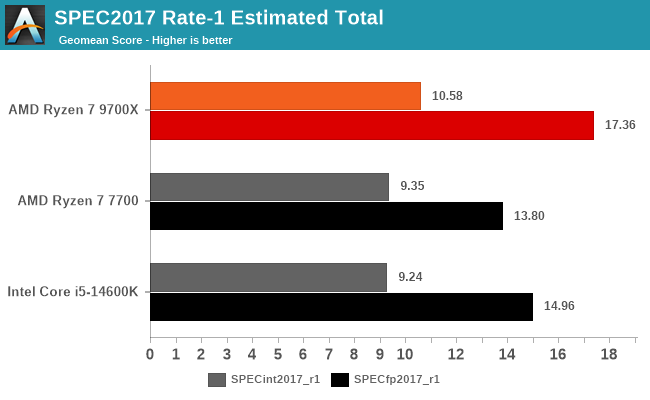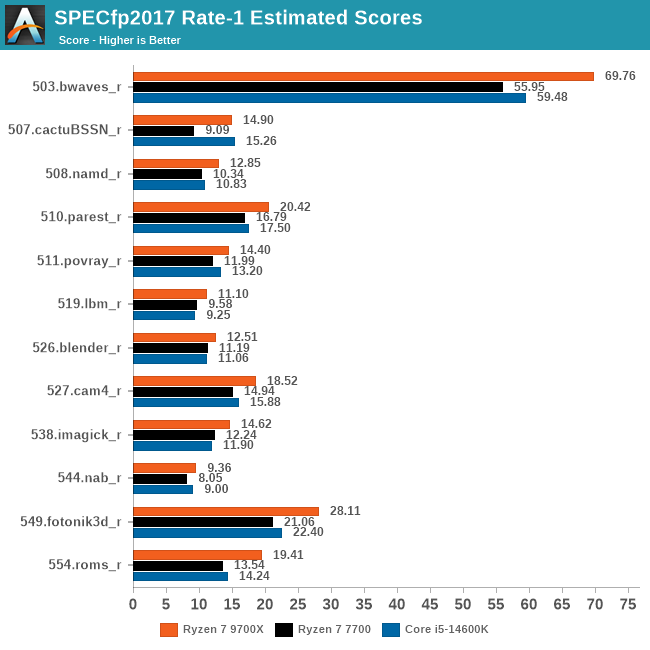The AMD Ryzen 7 9700X and Ryzen 5 9600X Review: Zen 5 is Alive
by Gavin Bonshor on August 7, 2024 9:00 AM ESTSPEC CPU 2017 Performance
SPEC CPU 2017 is a series of standardized tests used to probe the overall performance between different systems, different architectures, different microarchitectures, and setups. The code has to be compiled, and then the results can be submitted to an online database for comparison. It covers a range of integer and floating point workloads, and can be very optimized for each CPU, so it is important to check how the benchmarks are being compiled and run.
We run the tests in a harness built through Windows Subsystem 1 for Linux, developed by Andrei Frumusanu. WSL1 has some odd quirks, with one test not running due to a fixed stack size, but for like-for-like testing it is good enough. Because our scores aren’t official submissions, as per SPEC guidelines we have to declare them as internal estimates on our part.
For the launch of the Ryzen 9000 desktop chips, we've built a fresh set of binaries to better take advantage of the Zen 5 architecture. Specifically, as these are the first consumer chips since 2021's Rocket Lake (11th Gen Core) to offer AVX-512 support with a full, 512-bit wide SIMD backing it, we've built a new set of binaries to make use of the feature.
For compilers, we use LLVM/Clang for the C/C++ tests, and for Fortran tests we’re using GCC's GFortran. Ont he whole, LLVM offers better cross-platform comparisons, especially to platforms that only have LLVM support. However LLVM's modern Fortran compiler, LLVM Flang (aka Flang-new), is not production ready, whereas GFortran is. As always, we’re not considering closed-source compilers such as MSVC or ICC.
clang version 18.1.8
gfortran version 14.2.0
-Ofast -fomit-frame-pointer
-march=[x86-64-3 or x86-64-4, depending on chip's supported ISA]
Our compiler flags are straightforward, with basic –Ofast and relevant ISA switches. Because it's not possible to build a single set of binaries that offer AVX-512 support while still gracefully falling back to AVX2 on platforms that lack the feature, we're technically running two sets of binaries on x86 platforms. AVX-512 processors get binaries compbiled with the -march=x86-64-4 flag, while all other x86 platforms get -march=x86-64-3. And note that while scores are similar overall, the results from these new binaries are not comparable to our previous binaries, due to the significant compiler changes in the last few years.
To note, the requirements for the SPEC license state that any benchmark results from SPEC have to be labeled ‘estimated’ until they are verified on the SPEC website as a meaningful representation of the expected performance. This is most often done by the big companies and OEMs to showcase performance to customers, however is quite over the top for what we do as reviewers.
Single-Threaded (Rate-1) Results

With the new binaries, we've not yet had time to run the much longer multithreaded Rate-N tests, so for today's launch all we have is single-threaded results. Which is fine in this case, as we're primarily using SPEC as a means of evaluating IPCs and core architectural improvements.
And starting at a high level with the geomean scores, things look good for AMD's latest chip architecture. Even though we've already taken a preliminary look at Zen 5 with the Ryzen AI 300 launch last week, looking at the desktop chips gives us much more of a focused comparison, since the underlying AM5 platform hasn't changed from the Ryzen 7000 generation. Other than supporting slightly faster memory (DDR5-5600 vs DDR5-5200), the Ryzen 7 9700X and Ryzen 7 7700 are about as close as can be. The only thing keeping this from being strictly an IPC comparison is that the 9700X is clocked a bit higher, at 5.5GHz versus the 5.3GHz of the 7700 (a 3.8% advantage).
The actual performance advantage we find is easily in Zen 5's favor. Whereas the Zen 4 based Ryzen 7 7700 barely edged out the Core i5-1400K in integer performance, and trailed it in floating point performance, the Zen 5 Ryzen 7 9700X is ahead on all fronts. AMD's chip is a generation newer, and it certainly shows here.
By the numbers, the performance uplift in SPEC CPU 2017 over the 7700 is 13.2% for integer performance, and an impressive 25.8% for floating point performance. This is a greater uplift in both integer and floating point performnace than we saw with the mobile chips; the desktop chips show a distinct integer performnace improvement, and the floating point performance gains are even greater than before. In our preview piece, we theorized that Zen 5 is going to provide a greater floating point performance uplift than it will integer performance, and this seems to be validated by our benchmark results here.
We've not yet had the chance to run our x86_64-v3 (non-AVX-512) binaries on AMD's chips, so I won't speculate too much on the impact of a 512-bit SIMD in these scores. But the SPEC CPU benchmark suite is not known for being particularly sensitive on SIMD width to begin with, as it uses plenty of serial code.

Looking at the individual integer sub-test scores, we find a near-consistent performance improvement for the 9700X. With the exception of stubborn 505.mcf, the Zen 5 chip is always improving on its predecessor. The biggest gains coming in 500.perlbench, 525.x264, and the Forfran-focused 548.exchange2. Overall, the sub-tests tend to cluster in to two groups: about half the tests show minimal performance uplift, and the other half show extensive performance uplifts. This reflects the wide variety of workloads used by the sub-tests, and how not every workload is going to extensively benefit from AMD's architectural advances.

Coming from our geomean averages, where we saw that the 9700X beat the 7700 by 25%, looking at our individual scores we can see that AMD has significantly improved their floating point performance across virtually the entire board. Not only does the 9700X cleanly beat the 7700 in every last test here, but no sub-test score improves by less than 10%. So based on these results, there's little reason not to expect virtually all floating point workloads to benefit similarly.
The only caveat to improved floating point performance is that it's not as applicable to day-to-day productivity workloads, which historically are integer dominated. On the flip side, however, games are traditionally FP-bound, so Ryzen 9000's gaming performance should prove very interesting.
In the meantime, we'll bave updating this section later on this week with SPEC Rate-N (multi-threaded) results once those benchmarks have completed.










70 Comments
View All Comments
Golgatha777 - Wednesday, August 7, 2024 - link
Thanks for the review. I personally would have liked to see a 7800X3D in the benchmarks. Also, I would have omitted 720p and replaced it with 1440p gaming benchmarks. 1080p is perfectly fine for a synthetic benchmark to see which CPU is faster overall and a lot of gamers run 1440p.kpb321 - Wednesday, August 7, 2024 - link
Agreed. The 7800X3D should be very close in price to the 9700X so having both in the gaming charts would be pretty nice. Offhand I assume it will be a mix. For standard game the 9700x should have a small lead due to the Zen 5 improvements. For things that are cache sensitive that will make the 7800X3D more competitive or even faster.heffeque - Wednesday, August 7, 2024 - link
It doesn't make sense.The 7800X3D should be compared to the 9800X3D (which will come in a few months).
Trackster11230 - Wednesday, August 7, 2024 - link
It makes sense to compare the 7800X3D to the 9700X due to price, and I'm sure it'll be compared against the 9800X3D when it comes out too. These aren't mutually exclusive.Klober - Wednesday, August 7, 2024 - link
Seriously? Did none of you pay attention to the charts? There's clearly a 7800X3D in all but 2 of the charts on this page alone. I could maybe see an argument made for the 7900X3D (coincidentally, the CPU I have which I why I noted it's missing) but not the 7800X3D.Trackster11230 - Wednesday, August 7, 2024 - link
Yes, I see it in the charts, hence my comment about it making sense being in here. It's similar in price to the 9700X, so it makes sense to compare from that metric. What's so difficult to understand?I could make an argument too that an 8c/16t CPU makes more sense to compare to than the 7900X3D with 12c/24t.
boozed - Wednesday, August 7, 2024 - link
Seems odd that the gaming CPU is missing from the gaming resultsboozed - Thursday, August 8, 2024 - link
"Note: We are currently benchmarking more processors as we speak"I should read harder
Oxford Guy - Friday, August 16, 2024 - link
They said that they would re-test the Intel chips over the weekend in May. Did those updated benchmarks ever get done and published?frshi - Wednesday, August 7, 2024 - link
The table says Quad Channel DDR support, I don't think that's true. It's 4 slots but it's dual channel, isn't it?